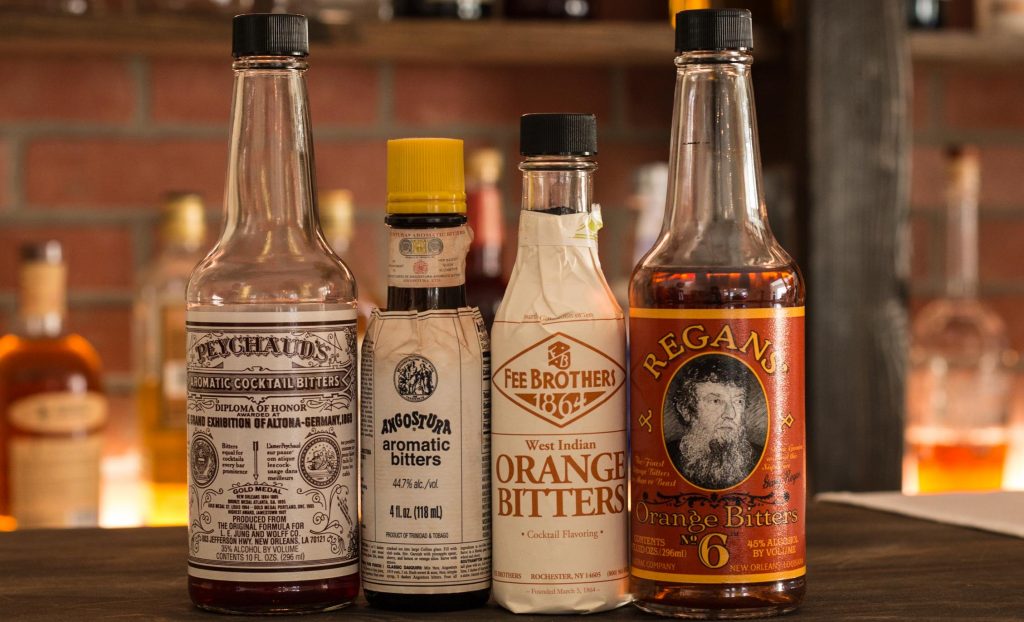HISTORY OF BITTERS
Bitters have a long and interesting history. They originated in the 18th century, when doctors first began mixing herbs and spices to create medicines. Over time, these concoctions evolved into the bitters we know today.
One of the most famous brands is Angostura, which was first created by Dr. Johann Siegert in Venezuela in 1824. It soon became popular around the world and is still widely used today in cocktails such as the Manhattan and Old Fashioned.
HOW BITTERS ARE MADE
Infusing a combination of herbs, roots, spices, and fruits in high-proof alcohol, typically a neutral spirit like vodka or grain alcohol, creates bitters. Moreover, the mixture, when steeped for several weeks, allows the flavors and aromas of the ingredients to infuse into the alcohol. Additionally, periodically agitating the liquid ensures even distribution of the flavors.
Once the steeping process completes, straining and filtering the mixture remove any solids or impurities. Some may have sugar or other sweeteners added, while others remain unsweetened.
The resulting liquid becomes highly concentrated, requiring only a few drops to enhance the flavor and complexity of cocktails and other mixed drinks. Different types exist, each with its own unique combination of ingredients and flavor profile.
Many bartenders and mixologists prefer making their own bitters, experimenting with various ingredients and techniques to create their signature blends. Whether homemade or store-bought, they serve as an essential ingredient in many classic cocktails and a versatile addition to any home bar.
TYPES OF BITTERS:

ANGOSTURA BITTERS:
Angostura bitters have been around for over 150 years. They are named after the town of Angostura in Venezuela, where they were first created by Dr. Johann Siegert.
Flavor Profile: Angostura bitters have a complex flavor profile that includes notes of cinnamon, cloves, and other spices. They are very aromatic and add a strong flavor to cocktails.
Cocktails: Angostura bitters are an essential ingredient in many classic cocktails, including the Manhattan, the Old Fashioned, and the Pink Gin. They are also used in non-alcoholic drinks, such as ginger ale or lemonade, to add a unique flavor profile.
Brand: Angostura bitters are produced by The House of Angostura, which also produces other popular products such as rum and amaro. They come in a distinctive oversized bottle with a yellow label and are widely available in most liquor stores.
PEYCHAUD’S BITTERS:
Peychaud’s bitters were first created in the 19th century by Antoine Peychaud, a New Orleans pharmacist. These have a distinct flavor profile and have become an essential ingredient in many classic cocktails.
Flavor Profile: Peychaud’s bitters possess a sweet, floral flavor with distinct notes of anise and cherry. They contribute a unique layer of complexity to cocktails and exhibit less bitterness compared to other bitters.
Cocktails: They play an indispensable role as an ingredient in the classic New Orleans cocktail, the Sazerac, and other renowned cocktails like the Vieux Carre, the Manhattan, and the Old Fashioned. Moreover, bartenders and mixologists employ them in non-alcoholic beverages such as lemonade or sparkling water to introduce a distinctive flavor profile.
Brand: Peychaud’s bitters are produced by the Sazerac Company, which also produces other popular bitters such as Regans’ and Scrappy’s. They come in a distinctive bright red bottle and are widely available in most liquor stores.
ORANGE BITTERS:
The process of making orange bitters involves infusing a variety of herbs and spices with bitter orange peel. Antoine Peychaud, a pharmacist in New Orleans, originally created them over 150 years ago. Since then, orange bitters have gained widespread popularity and now serve as an essential ingredient in many classic and modern cocktails.
Flavor Profile: Orange bitters, with their bright and citrusy flavor, skillfully infuse delightful notes of orange peel, coriander, and cardamom. These exquisite elements intricately contribute to a subtle layer of complexity in cocktails, enabling them to harmoniously balance out a wide range of flavors, whether sweet or savory.
Cocktails: Orange bitters are a versatile ingredient that finds application in a variety of cocktails. Some classic cocktails that incorporate orange bitters include the Negroni, the Manhattan, and the Old Fashioned. Additionally, they are used in modern cocktails like the Orange Blossom, which combines gin, orange bitters, and orange blossom water to create a refreshing and floral drink.
Brands: There are several brands on the market, including Regan’s, Fee Brothers, and Angostura. Each brand has its own unique flavor profile, so it’s worth trying a few different brands to find your favorite.
COCKTAILS:
OLD FASHIONED
Ingredients
- 2 oz bourbon or rye whiskey
- 1 sugar cube or 1 tsp granulated sugar
- 2 dashes Angostura bitters
- Orange peel
- Ice
- Club soda (optional)
Instructions
combine 2 oz bourbon or rye whiskey with 1 sugar cube, 2 dashes Angostura bitters, and a splash of club soda (optional) in an Old Fashioned glass, muddle until sugar dissolves, add ice, stir, and garnish with a twist of orange peel.
MARTINI
Ingredients
- 2 1/2 oz gin
- 1/2 oz dry vermouth
- 1 dash orange bitters
- Orange twist for garnish
Instructions
Combine 2 1/2 oz gin, 1/2 oz dry vermouth, and 1 dash orange bitters in a mixing glass with ice, stir for 30 seconds, strain into a chilled martini glass, and garnish with an orange twist.
SAZERAC COCKTAIL:
Ingredients
- 2 oz rye whiskey
- 1 tsp simple syrup
- 2 dashes of Peychaud’s bitters
- Absinthe or Herbsaint rinse
- Lemon twist for garnish
Instructions
To make a Sazerac, rinse a chilled rocks glass with absinthe, stir together 2 oz rye whiskey, 1 tsp simple syrup, and 2 dashes of Peychaud’s bitters with ice, strain into the prepared glass, and garnish with a lemon twist.
In conclusion, bitters are a versatile and essential ingredient in the world of cocktails. With their long and storied history, there are countless varieties available today, each with their own unique flavors and characteristics.
